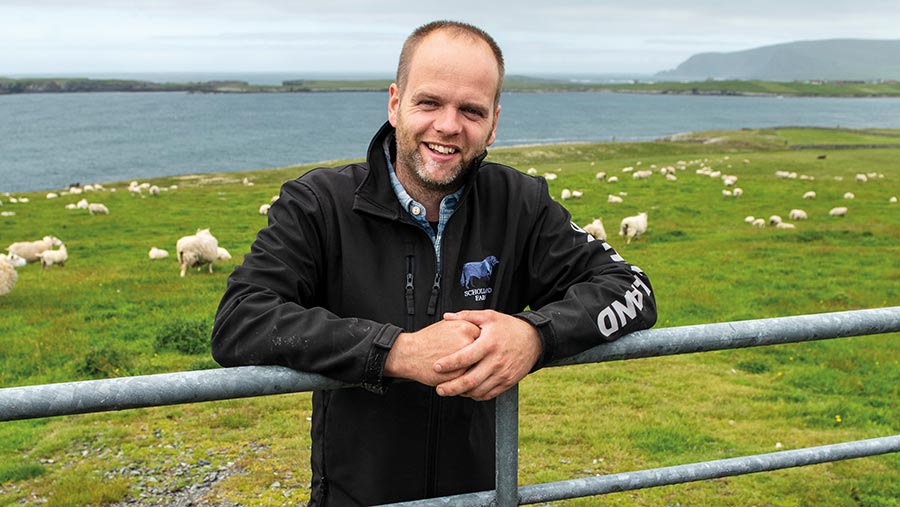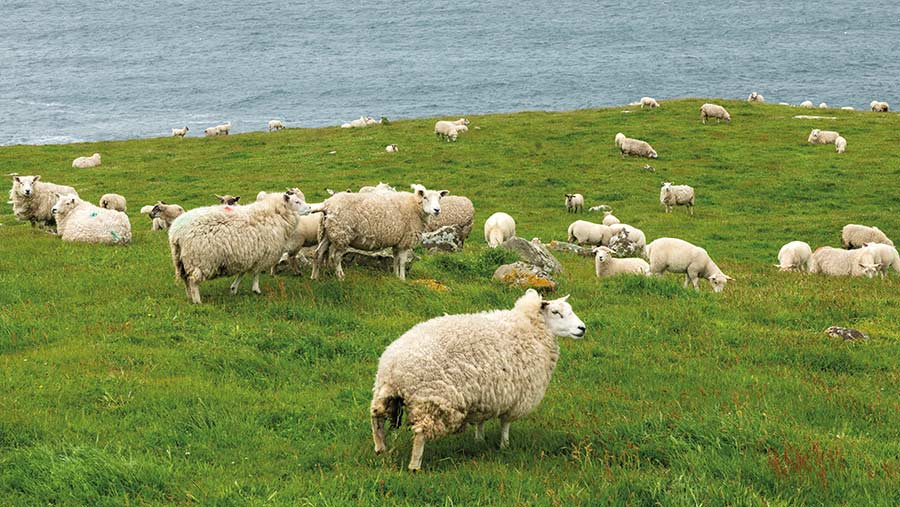Mixed farmer reaps premium price via direct meat marketing
 © Dave Donaldson
© Dave Donaldson Selling livestock direct to local butchers and marketing produce via a meat box scheme is helping Shetland farmer Jamie Leslie cut out the middlemen to reap a premium price for his stock.
Mr Leslie and wife Louise sell, on average, 20 lambs, 10 pigs and four fat cattle to the island’s butcher shop each week, year-round.
The couple specifically created a livestock rearing and fattening system to produce a constant yet steady supply of meat, at the desired target weights. They pride themselves with a close relationship with the butchers.
“We have a really great partnership with the local butchers, with weekly contact to ensure expectations are met.
“It’s rewarding seeing our produce on sale and presented well – it is a thrill every time,” says Mr Leslie.
See also: How to ensure heifers calve down a second time
Quality produce
Beef from Scholland Farm’s Aberdeen Angus herd has been supplied to local butchers for more than 20 years, but when a new start-up shop called Sound Butchers established, the proportion of meat sold direct grew.
From the outset, the butchers wanted a well-handled 290-330kg carcass with nice fat cover, good marbling and the story of where it’s from.
In the first year of the new venture, beef carcass weight averaged 309kg and a total of 27.5t was supplied. Last year, carcass weight averaged 320kg.
Beef sales continue to grow and Mr Leslie hopes to sell more than 30t this year.
“Quality of our produce is more important than quantity, but as long as we can keep quality at the highest standard, we will continue to push output,” he says.
All beef and pigs and a proportion of lambs are now sold direct. Pig deadweights average 75-85kg, while lambs average 19-20kg.
The Leslie family hope to increase the amount of lambs sold direct through the imminent launch of the Sound Butchers’ Shetland Lamb Biltong range.

© Dave Donaldson
Biltong is a dry-cured, jerky-style marinated meat that is thinly sliced and sold as a snack.
After a successful range selling beef biltong, the butcher shop is launching the lamb equivalent. Mr Leslie hopes to supply up to 600 lambs a season to support product development.
Continual supply needed
Selling direct creates a more stable pricing mechanism and ensures a greater slice of the retail pound, but this doesn’t come without its challenges.
“We need a constant supply of quality stock year-round to meet demand, which is the biggest challenge to overcome,” says Mr Leslie.
As demand grew, the farm could not rear enough home-grown cattle from the 90-strong suckler herd, which led Mr Leslie to source Angus heifers direct from two Scottish farms to grow on and fatten.
A system was designed with four different categories of cattle to create a constant meat supply.
These are home-reared heifers and steers born in March and April and killed the following July.
Followed by 50 bought in over winter cattle born in May and June. From this, he picks out the larger animals to push on for fattening, while the remaining cattle are kept back and fed on silage for eight to 10 weeks.
Cattle are mostly fattened off a home-grown silage and barley mix or are grazed in a leader-follower system during the spring and summer months. A small proportion of concentrate feed is included in the diet.
The leader follower system initially involves grazing ewes and lambs, followed by suckler cows and calves, which slashed concentrate costs and increased grass use by 345kg dry matter (DM)/ha a day.
This added an extra 2kg to lamb weaning weights and increased cattle daily liveweight gain by 0.42kg. The grassland management system is remarkable, given that some soils contain up to 76% sand.
Pig enterprise
In 2021, the family started a pig fattening enterprise, sourcing weaners from a farm in Aberdeenshire.
A mix of Large White, Land Race and Hampshire Boar piglets are bought in every other month in batches of 30 weighing 25-35kg. These are fed a blend of barley, wheat, soya and maize.
Batches of pigs are often reared in the cattle calving courts for six to eight weeks, where they naturally burrow into the manure and transform it into compost.
“After we take an early cut of silage in June, we apply the compost before direct-drilling kale into the pasture,” he says.
Pork popularity continues to rise across the island and Mr Leslie hopes to expand his pork enterprise to 300 pigs a year.
“We even introduced a ‘Grown Out’ outdoor range and reared a batch of 30 pigs outside last summer,” he says.
This July, he is providing hog roasts for attendees of the Tall Ships sailing regatta, hosted in Lerwick, Shetland.
The event sees dozens of ships make their way to a number of European ports and he is looking forward to supplying meat to the event.
Genetics and breeding of cattle and sheep
Continued vigorous selection of cattle and sheep helps drive herd and flock performance.
Dealing with brutal weather and blowing sand soils, livestock must be able to tolerate the challenges of Shetland weather.
Fertility, body condition score (BCS), lameness and temperament are the main priorities when selecting cattle.
“Any mature cow under BCS 2.5 at the end of winter is not retained. They must get fat and use those reserves to reduce winter feed costs, but not at the cost of fertility,” says Mr Leslie.
When selecting replacements, any heifer whose mothers have left the farm before the age of eight due to feet, fertility, temperament or BCS, the daughters are not kept.
“Ewes must bounce back from lactation quickly – any needing long-term preferential feed are moved to the B-mob and tupped to a terminal sire. Any cow or ewe who makes work has to go,” he says.
A shift away from Shetland sheep genetics and focusing on a three-way composite of Romney, Lleyn and Texel ewes is allowing a greater selection pressure.
Lambing started at the end of April with a scanning percentage of 177%.
The Farmers Weekly 2023 Mixed Farmer of the Year
Jamie Leslie was Farmers Weekly’s Mixed Farmer of the Year 2022.
Enter yourself for this award or one of the other categories for our 2023 awards on our Awards website

